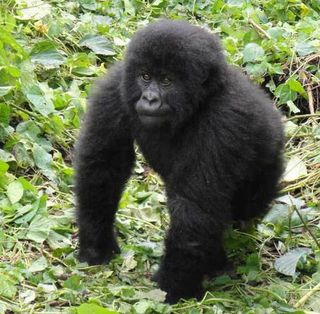Well-Mannered Gorillas Hand Down Tradition of Dainty Eating

Gorillas daintily snack on stinging nettles in ways that depend on where they were raised — differences in table manners that point to unique customs, just as is true with chimpanzees, orangutans and humans.
In the wild, chimpanzee troops engage in practices specific to each group that altogether seem to form unique cultures, including various forms of tool and weapon use. Orangutans show these variations, too, with research showing how one orangutan group cracked open nuts with stones and branches, while a group on the other side of a river did not.
Stinging snacks
To see if gorillas learn socially, scientists compared wild mountain gorillas in Rwanda with nine lowland gorillas at Port Lympne Wild Animal Park in England. Gorillas "have been seen as the poorer cousins to chimpanzees when it comes to studying these sorts of skills," said researcher Catherine Hobaiter, a primatologist at the University of St. Andrews in Scotland— that is, perhaps not as capable of developing unique traditions.
Both groups could feed on stinging nettles — flowering plants whose stems and leaves are covered in hollow stingers — if they wished. "Some people used to think that gorillas simply shoveled great handfuls of food into their mouths indiscriminately, while in reality they have incredibly dexterous and detailed techniques for processing the different plants in their diet," Hobaiter said.
The scientists found the wild gorillas first strip leaves from the nettle stems and twist off their sting-loaded stalks. They next carefully fold this bundle of leaves over their thumbs, with the undersides up to keep the stings on the top side, and then pop the packages into their mouths, according to videos taken by researcher Richard Byrne at the University of St. Andrews. [See Video of Gorillas Eating Nettles]
("Despite being a wild community, the individuals there are very well habituated, and it was possible to sit and film their natural behavior at very close quarters," Hobaiter noted.)
Sign up for the Live Science daily newsletter now
Get the world’s most fascinating discoveries delivered straight to your inbox.
In contrast, the gorillas at the animal park, all but one of which had been raised in captivity, stripped nettle leaves off their stem but left the sting-laden stalks on. Then they just squeezed the leaves, and stems, together into a bundle and ate them.
"I spent two weeks over the summer when the nettles were in their growing season, filming the gorillas each day," Hobaiter recalled. "At first we weren't sure if nettle processing would be a rare event, but I very quickly realized that despite being regularly fed on a broad diet, almost everyone was processing nettles on a very regular basis, so it's clearly something that they're all pretty keen on."
The dominant captive male, Djala, "was particularly keen and would sit and strip stem after stem, quickly and tidily processing the leaves and popping them in his mouth," Hobaiter said. "Not everyone was quite so skilled, though, and while the adult females would often prevent the very youngest infants from having a go at all, some of the younger juveniles would occasionally try to swallow some very untidy looking bundles ? which, from the look on their face, seemed to have a few too many stings left sticking out in the wrong places."
Gorilla culture
The ability to learn socially is "one of the most powerful learning tools we as humans have," Hobaiter said. For instance, we can watch another individual perform an elaborate task, "such as baking a cake, and learn not only how to achieve the same end result, a tasty dessert, but to pick out which parts of the task are key to success and must be repeated every time — adding the right ingredients in the right order and mixing them in the right way — and which are not," Hobaiter said.
In the same way, the essential elements used in nettle processing — pull apart, strip off leaves — were common in both gorilla groups, though each group had its own way of carrying out those procedures. Individuals might vary slightly from others in their own group, but much less so than from members of a different group.
"This suggests that not only do gorillas appear to acquire their nettle-processing skills socially, but that they do so not by slavishly copying every detail of another's behavior by learning at an organizational level — that is, they learn the technique or order in which the key elements have to be combined to achieve success," Hobaiter told LiveScience.
Ideally, researchers would want to compare different groups of gorillas in the wild, "but the opportunities to do so are incredibly rare," Hobaiter said.
Byrne, Hobaiter and their colleague Michelle Klailova detailed their findings online April 21 in the journal Animal Cognition.
Follow LiveScience for the latest in science news and discoveries on Twitter @livescience and on Facebook.

Most Popular




